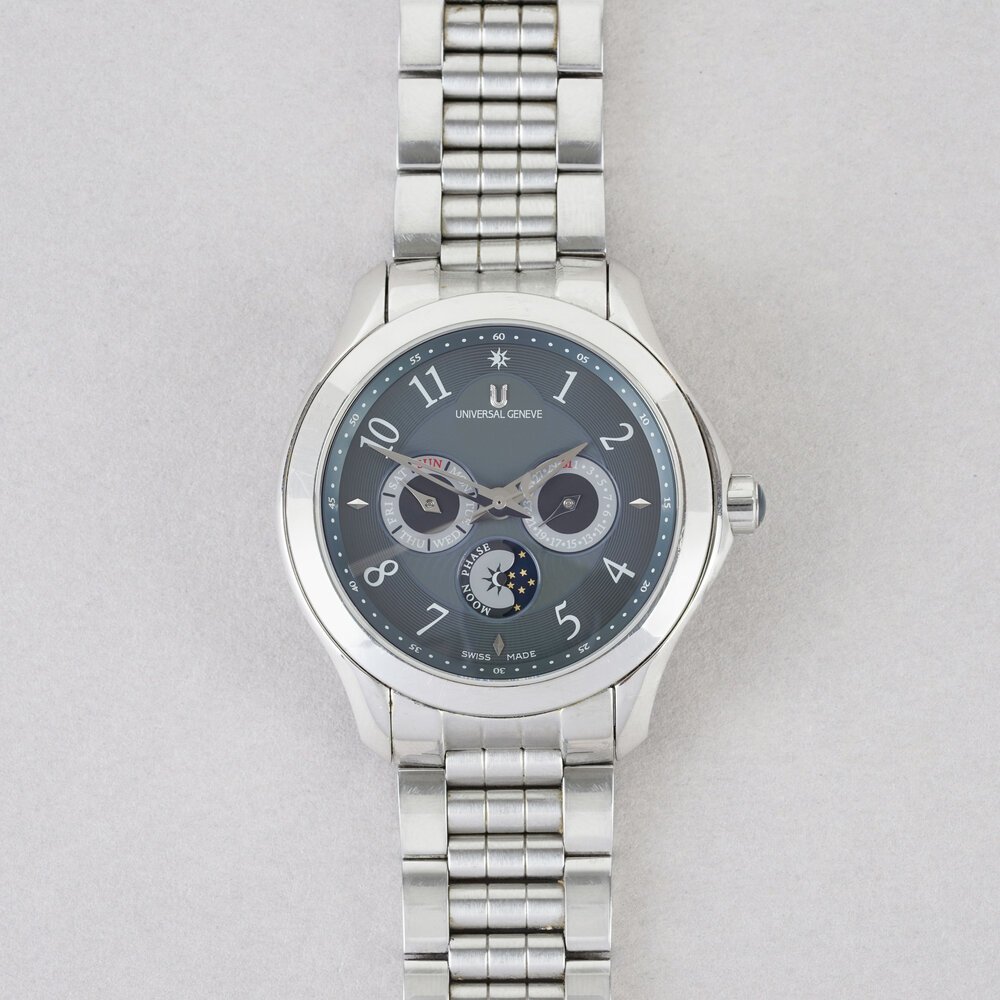A guide to vintage Universal Geneve watches

Published: Aug 04, 2022
Despite being an extinct watch brand, Universal Geneve lives on through its highly collectable vintage wristwatches, which have drawn vintage watch enthusiasts in from all four corners of the globe in the thousands over recent years. Part of this is to do with a vintage boom, which has spurred many luxury watch brands into recreating vintage-inspired watches based on popular models from a bygone era. Sadly, for Universal Geneve, this is not possible, but by digging into its archives, Universal Geneve watches have seen a renaissance in a new generation of enthusiasts.
To understand why vintage Universal Geneve watches are so popular, it is worth taking a look at the brand’s history and how the company evolved from the year 1894 onwards…
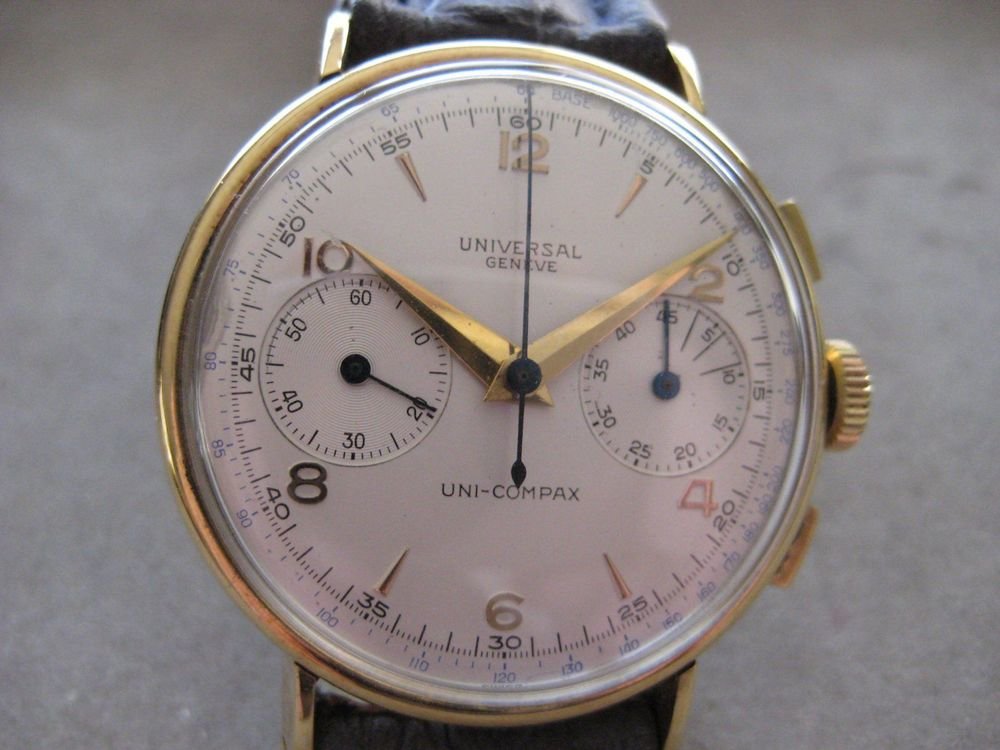
The history of Universal Geneve
When Universal Geneve was first founded in Le Locle in 1894 it was considered an establissage – a place where various parts of a watch were assembled. This included taking ebauche movements and fitting them to the heart of a watch, then shipping them out to watch suppliers. The movements would also be inspected and the dials all arranged under one roof. By 1919 Universal Geneve had relocated to Geneva. After this, the two students, Ulysse Perret and Numa-Emile Descombes that founded the company patented their first 24-hour indication watch. After Descombes’ death, Perret partnered with Louis Edouard Berthoud and began manufacturing pocket watches and trench watches for use during the First World War. Soon after this, the Auto Rem watch was developed, with an unmissable octagonal-shaped case with lozenge hands and a 16-jewelled movement.
Compur and Aero Compax watches by Universal Geneve began production during the 1930s at a time when the impractical pocket watch had been phased out and replaced by a wrist-worn watch. These were automatic watches that boasted a smooth sweeping second hand. The Aero Compax alone was developed in many variations and was well-utilised by those in combat. The watch was offered in moon phase, Master Vortex and Medico iterations. Although Universal Geneva was enjoying plenty of success with the Aero Compax chronograph, the collaboration with Parisian designer Hermès International S.A brought about an even more refined chronograph watch with a more legible dial design that featured large Arabic numerals. It was powered by a movement developed by Breguet with balance springs for improved mechanical efficiency.
As well as producing popular military chronograph watches, Universal Geneve also turned its attention towards manufacturing Art Deco-inspired wristwatches aimed at women. Actresses and wives of political leaders were wearing the Universal Geneve Couture Diamond watch, available in platinum, stainless steel or a more luxurious 18ct yellow gold. A mother of pearl inlay and a bezel set with scintillating diamonds made this a collector’s piece imbued with luxury, finesse and indulgence.
Post Second World War years were defined by Universal Geneve’s release of the Polerouter watch, which was produced during the 1950s and the 1960s. The watch was designed by Gerald Genta and was utilized by professional pilots, particularly those from Scandinavian Airlines who made routine flights over the north pole using this watch. It was tailor-made to handle fluctuations in temperature and air pressure, making it a particularly robust and reliable timekeeping instrument for anyone navigating the skies during this era.
During the 1980s, the Golden Shadow and White Shadow watches were released by Universal Geneve. These were characterised by their resolutely thin case designs manufactured from luxurious 18ct yellow gold and 18ct white gold. During this era, Bulova took over the company and opened up the opportunity to work with the likes of Cartier, Tiffany and Movado. Then, to keep up with the demands of the quartz crisis, which swept through the Swiss watchmaking industry during this time, Universal Geneve watches took the decision to phase out its automatic watches and began focusing on developing quartz watches before returning to manufacturing mechanical watches once more. In the late 80s, Universal Geneve was taken over by Hong Kong-based Stelux Holdings International, Ltd.
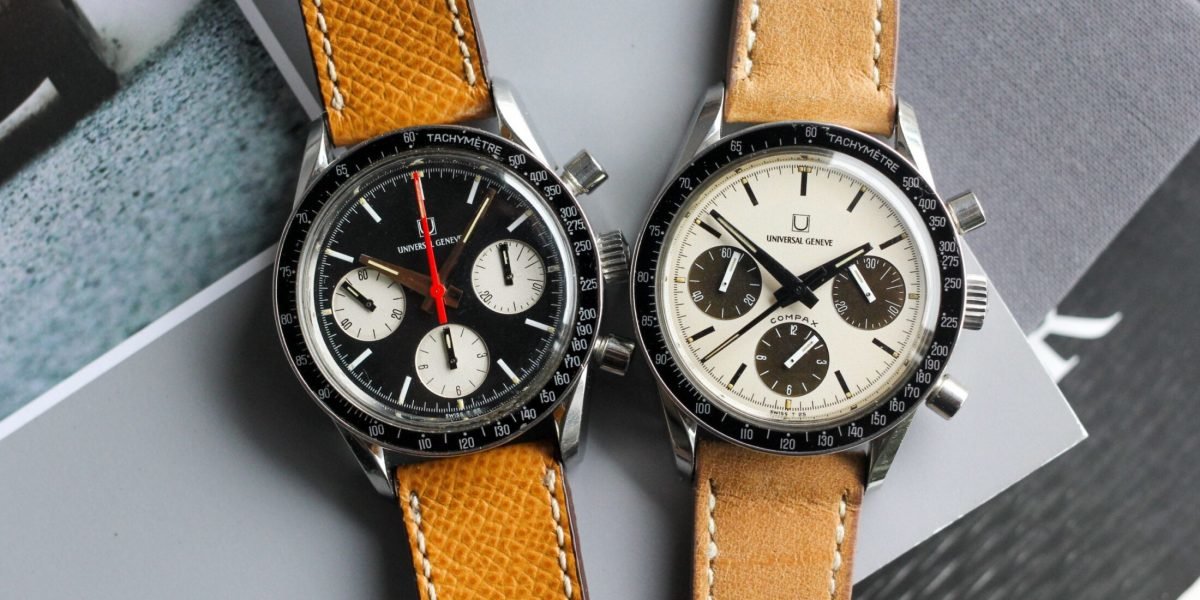
The best vintage Universal Geneva watches to collect
Universal Geneve Cal. 138SS automatic
Although Universal Geneve is best known for its chronograph watches, what makes this particular model even more collectable is perhaps the fact this watch is a simple three-hander, packed full of charm and character. This elegant vintage Universal Geneve watch boasts a beautiful eggshell-coloured dial, with dauphine-shaped hands and hour markers with a tapered base. This is a 35mm case size with a stainless steel construction and a plexiglass front for protecting the surface of the dial from denting, scratching, heat, moisture and light damage. Three-handed models like this Universal Geneve watch that are powered by the 138SS calibre are fitted on leather bands, like this dark brown leather strap, completing a very vintage feel and look.
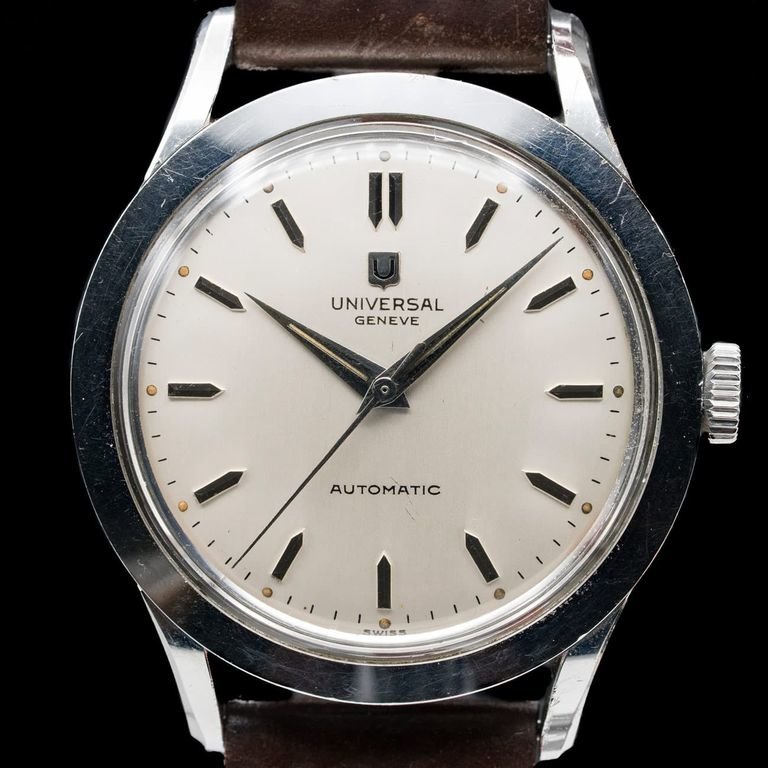
Universal Geneve
Reference: 138SS
Case/Dial: 35mm
Movement: Universal 138 SS, Self-winding
Style: Classic
Universal Genève Compax 885 103/01 “Evil Nina”
The Universal Geneve Compax 885 103/01 “Evil Nina” watch and the follow-on 995 103/01 were developed in tribute to the wife of German-born racing driver, Karl Jochen Rindt (1942-1970) who represented Austria during his career. The watch is a popular collectable thanks to its vintage racing-inspired aesthetic and legible, sporty black dial, with chronograph counters placed in a tri compax layout at 3, 6 and 9 o’clock.
In a black and white photo of Mrs Rindt in August 1970, we see her at the Austrian Grand Prix at Osterreichring, where Jochem gets the pole position on his Lotus-Ford but could not start because of technical problems. She is wearing a panda dial Universal Geneva Compax watch with a white dial and black-filled chronograph counters – the reference 885 103 / 02. Since then her name has been inextricably linked to the brand.
In this design, the striking red-coloured central chronograph second hand adds a sporty touch to the watch, as does the tachymeter scale applied to the surface of the model’s black bezel. The watch is completed on a stylish brown calfskin leather strap. Rindt accidentally died in the practices of the Italian Grand Prix at Monza and became the only pilot to be posthumously awarded the title of Formula 1 World Champion, making this Universal Geneve Evil Nina watch an even more interesting timepiece to collect.
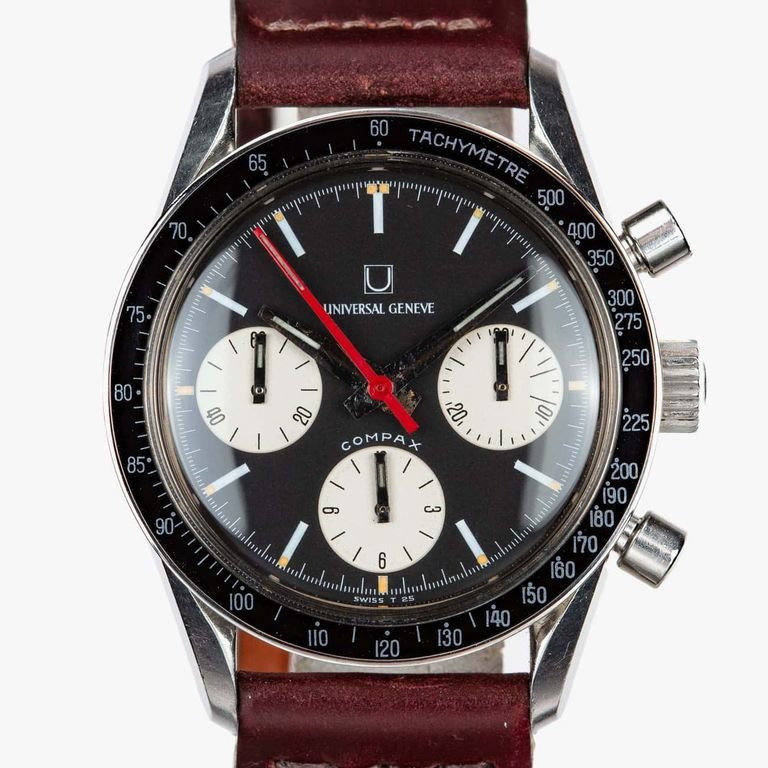
Universal Geneve Polerouter
Gerald Genta designed the famous and highly desirable Universal Geneve Polerouter watch. In this no date design, the model’s black gloss crosshair dial is home to a simple and spacious layout and features a silver inner bezel, curved lug case, and dauphine hands. The story behind the Polerouter is that it was Gerald Genta’s first design brought to market, bringing him great success to begin his career. The first Universal Geneve Polerouter watch was developed and released in 1954 and was known for its high resistance to magnetic fields, making it particularly suitable for use by pilots of Scandinavian Airlines.
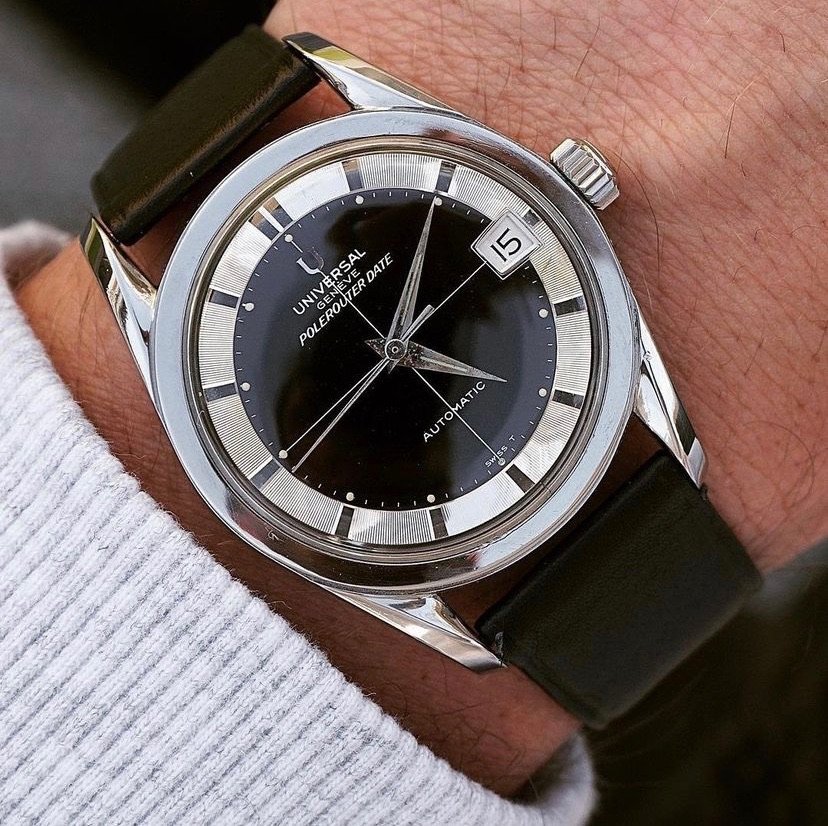
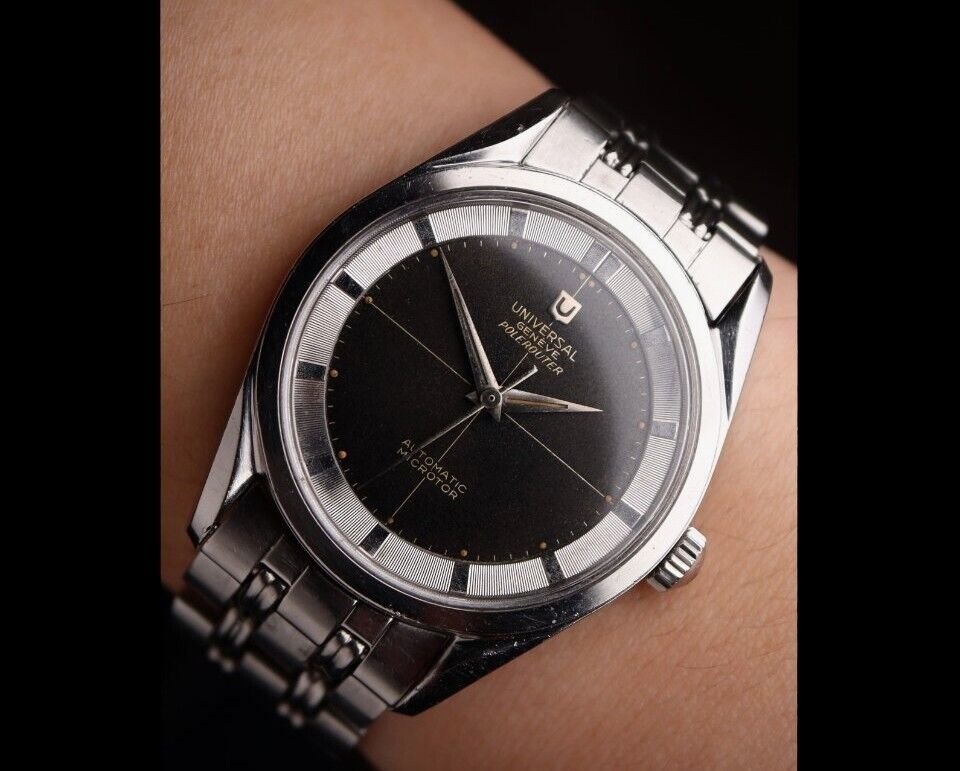
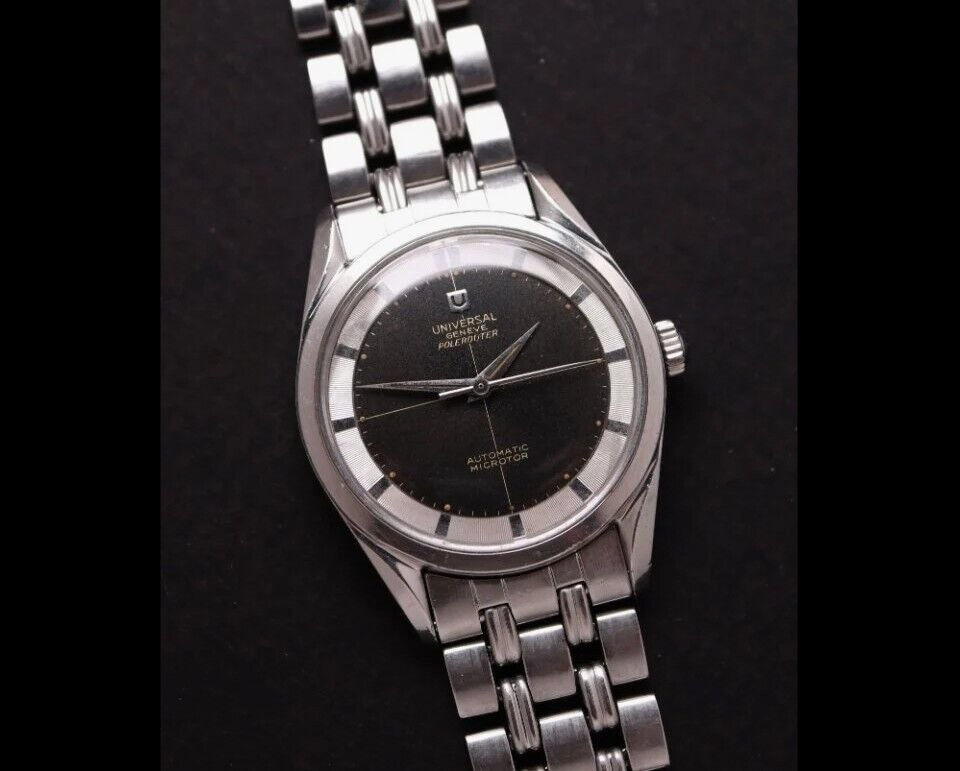
Universal Genève Space Tri-Compax Moonphase
The Universal Genève Space Tri-Compax Moonphase is a remarkable and highly sought-after vintage timepiece, renowned for its intricate design and multifunctionality. This watch is a quintessential example of Universal Genève's craftsmanship and innovation, combining a chronograph function with a full calendar and moonphase display. The Space Tri-Compax Moonphase stands out for its elegant yet complex dial layout, showcasing day, date, and month indicators along with the moonphase complication, a feature that tracks the lunar cycle. Its aesthetic appeal is matched by the precision of its mechanical movement, making it a prized possession among collectors.
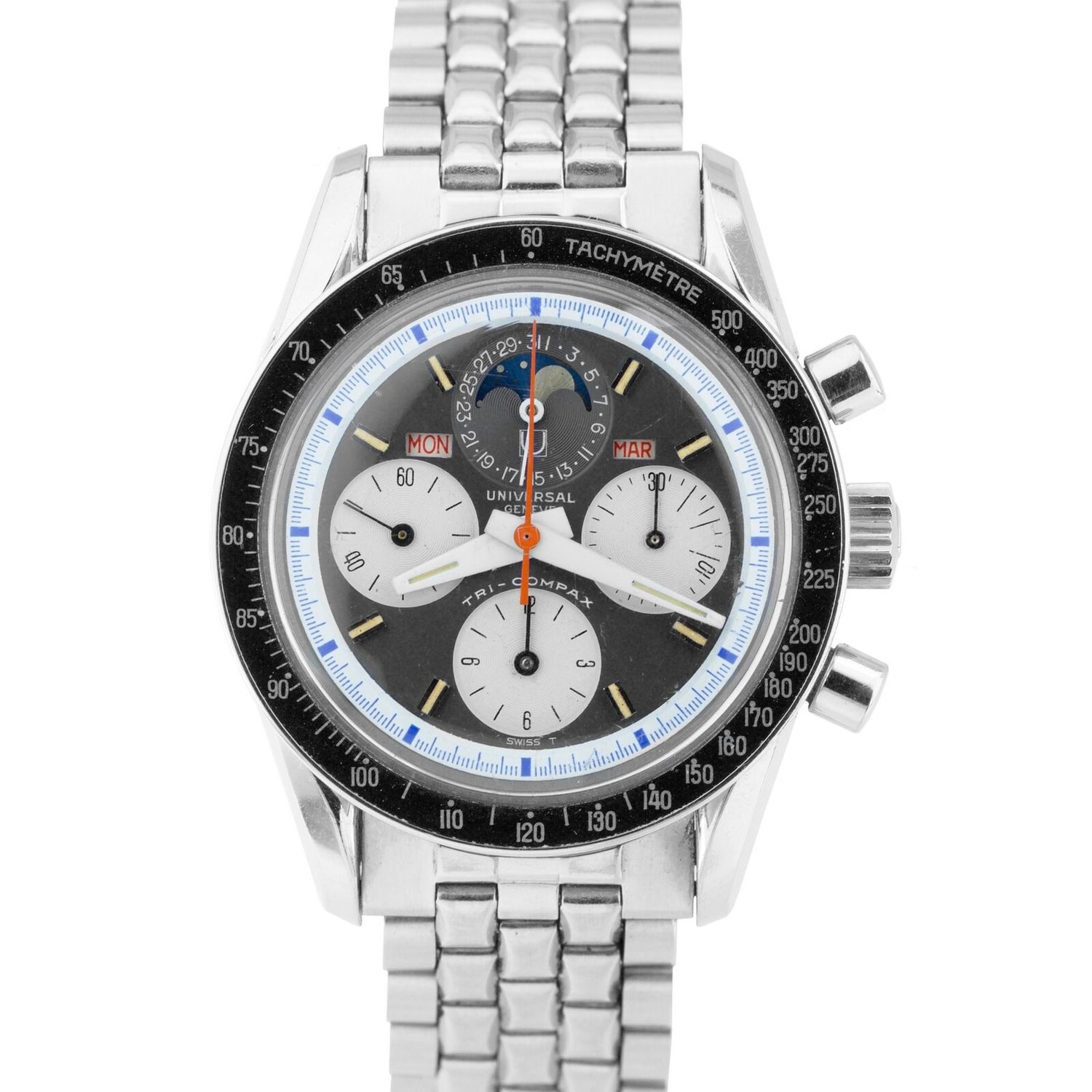
The watch not only tells time but also serves as a testament to the golden era of Swiss watchmaking, where functionality met artistry. The Space Tri-Compax Moonphase, with its rich history and sophisticated features, continues to captivate watch enthusiasts worldwide.
Universal Geneve Space Compax
The Space-Compax was introduced in the 1960s, a period marked by a growing fascination with space exploration and a booming interest in sports and tool watches. Case and Construction: Typically housed in a stainless steel case, the Space-Compax is known for its robust and durable design, suitable for professional use. Dial Layout: The watch features a distinctive dial, often with contrasting sub-dials, providing a clear and legible display. This layout is characteristic of chronograph watches from that era.Chronograph Function: As a chronograph, it includes features like a stopwatch function, essential for timing events with precision.Water Resistance: Early models were designed with a degree of water resistance, making them suitable for use in various environments. Model Variants: Over the years, several variants of the Space-Compax were released, some featuring different dial colors, case sizes, or movement types.
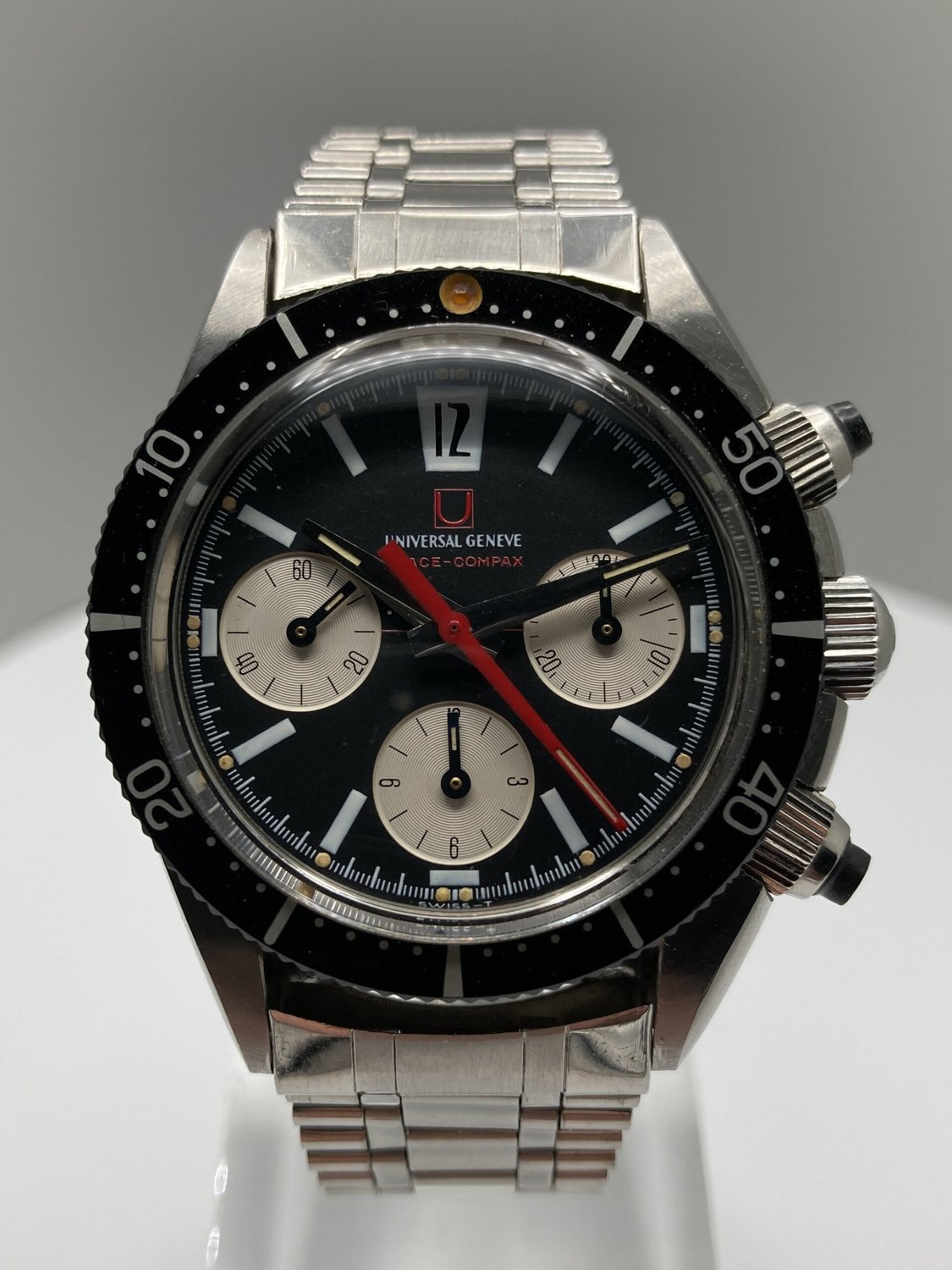
Collectors' Interest: The Space-Compax has become a sought-after model among collectors, particularly due to its historical significance and rarity. Vintage models, especially those in good condition or with unique features, have seen significant appreciation in value.
Caliber: The watch is typically powered by a mechanical movement, known for its precision and reliability. The specific caliber can vary depending on the model and production year.
Space Age Influence: The name "Space-Compax" reflects the era's fascination with space exploration, a theme that was prevalent in design and culture during the 1960s. The Space-Compax is part of the broader history of chronograph watches, which have played a significant role in both sports and professional contexts.
Cairelli Split-Seconds Chronograph
The Universal Geneve Split Seconds Chronograph watch was first released during the 1950s. The tool was developed for Italian Air Force personnel and featured an innovative 24-hour indicator, paired with Hindu-Arabic numeral hour markers, surrounded by a 44mm bezel. The Valjoux 55 powered this military tool watch. Even more interesting is that the Cairelli watch features only two registers for the chronograph complication and no additional chronograph scale. The watch comes fitted on a canvas strap in a vintage beige colour and the dial features a striking set of blued Breguet-style hands, adding to a very clean and crisp display.
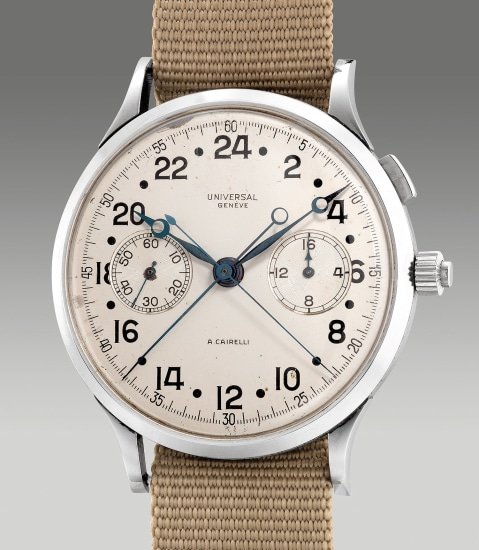
Universal Geneve Aero-Compax
The Aero-Compax watch oozes powerful nostalgia and was first launched in 1941. Serving as a powerhouse to the watch was the Calibre 285 – a manual winding movement with a column wheel and a crown at the left side of the watch. Aero-Compax watches by Universal Geneve are some of the most highly sought-after watches from the manufacturer’s historical catalogue. Models like the ref. 24209 are powered by the Calibre 287 and were developed circa 1942. Originally fitted on a brown leather strap, it features; a GMT second time zone register at the 12 o'clock position, a constant seconds indicator at 9 o'clock, a 12-hour totalizer at 6 o'clock, and a 30-minute register at 3 o'clock.
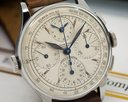
Universal Geneve Vintage Aero-Compax SS
Reference: 24209
Case/Dial: 36mm
Movement: Valjoux 55, Self-winding
Style: Chronograph
Universal Geneve Okeanos Moon Timer Triple Calendar
Universal Geneve Okeanos watches like this model ref. 871.104 feature a moon phase indicator and a stunning grey dial which pairs nicely with a stainless steel bracelet. The model has a Universal-signed crown at 3 o’clock and a screw-down exhibition window caseback to showcase the performance of the automatic cal. 71.4. Large silver dauphine-style hands occupy the dial of this model, along with the moon phase indicator at 6 o’clock, a date ring at 3 o’clock, and a month counter at 9 o’clock. Its unmistakable design is a sought-after timepiece from the pre-owned Universal Geneve watch marketplace, thanks to its selection of features that come in handy for any modern-day watch wearer today.
